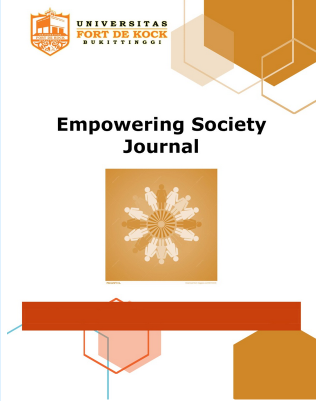PENERAPAN KOMUNIKASI NON VERBAL PADA PERMAINAN TRADISIONAL ANAK
Abstract
Traditional games are a form of play therapy for children to increase motor skills. The application of non-verbal communication when playing can make children comfortable and stimulate children to understand the concept of the game more quickly. The aim of this community service is to see the application of educators' non-verbal communication in children's traditional games, especially in seeing children's growth  and development. The methods used in this PKM include; sharing information about the application of non-verbal communication in the traditional game "hi hi smart child", demonstrations to educators and kindergarten/PAUD children, and implementation of games by assessing children's motor skills before and after traditional games accompanied by non-verbal communication. The PKM results show that there is an increase in children's gross motor skills like speed and agility after being given traditional games accompanied by non-verbal communication. It is hoped that the TK/PAUD can continue this activity and carry out continuous evaluations, so that they can improve the quality of children's growth and development.
References
Alimuddin, A., & Wairata, S. G. (2018). Efektivitas Komunikasi Non-Verbal Pada Anak Tunarungu Dalam Berkomunikasi Di Slb Rajawali Makassar. Al Qisthi Jurnal Sosial Dan Politik, 8(1), 88–108. https://doi.org/10.47030/aq.v8i1.56
Ananda, D. (2021). Implementasi Terapi bermain Dalam Meningkatkan Kreatifitas Anak Di TK Nurul Ilmi Kelurahan Paccinongan Kecamatan Somba Opu Kabupaten Gowa. In Fakultas Dakwah dan Komunikasi (Issue 1). http://journal.unilak.ac.id/index.php/JIEB/article/view/3845%0Ahttp://dspace.uc.ac.id/handle/123456789/1288
Elfatihi, M. (2016). The Role of Nonverbal Communication in Beginners’ EFL Classrooms.
Harini, B., Usman, N., & Maharani, S. D. (2021). Fenomena Permainan Tradisional “Cak Ingkling†Bagi Siswa Sekolah Dasar di Era Milenial. Publikasi Pendidikan, 11. https://ojs.unm.ac.id/pubpend/article/view/16374
Juwita, L., Rezkiki, F. N., Kartika, I. R., Safitri, Y., Prabowo, D. Y. B., Febrina, W., Laksmi, I. G. A. P. S., Raharjo, R., Switaningtyas, W., Fadlilah, M., Albyn, D. F., Hamu, A. H., & Dewi, R. (2022). Ilmu Keperawatan Dasar. Dotplus. https://winifit6.blogspot.com/2018/11/telenursing.html
Khoir, M., Fauzi, A., & Holis, W. (2020). Therapeutic Communication Skills of Nurses in Hospital. International Journal of Nursing and Health Services, 3(2), 686–694. https://doi.org/10.35654/ijnhs.v3i2.197
Maysarah, Putri, T. H., Fauziyah, N., & Saifuddin, M. (2023). Teac hers ’ Non -Verbal Communication in Teaching English to Young Learners. Formosa Journal of Science Technology, 2(8), 1939–1956.
Rahayu, L. D., & Ismet, S. (2021). Pengaruh Permainan Tradisional Boy-boyan Terhadap Perkembangan Motorik Anak di Taman Kanak-kanak Ramah. Jurnal Family Education, 1(3), 19–26. https://doi.org/10.24036/jfe.v1i3.13
Riskiati, Noni, N., & Baso, J. (2019). Teacher’s Verbal And Nonverbal Communication In Online EFL Class.
Ritonga, S. A. (2022). Pengaruh Permainan Tradisional Terhadap Kemampuan Motorik Kasar Anak Kelompok B Di Tk Diponegoro Asam Jawa. Tarbiyah Bil Qalam, VI(1), 26.
Sukamti, E. R. (2019). Perkembangan Motorik Kasar Anak Usia Dini Sebagai Dasar Menuju Prestasi Olahraga.
Yulita, R. (2017). Buku - Permainan tradisional anak Nusantara. Kementerian Pendidikan dan Kebudayaan Badan Pengembangan dan Pembinaan Bahasa.

